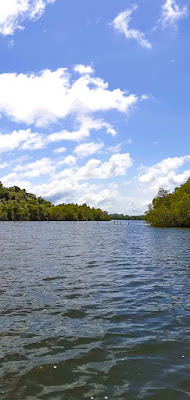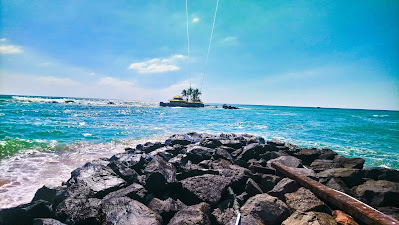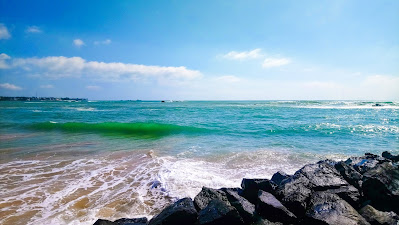Hikkaduwa,
Sri Lanka (Ceylon)
Hikkaduwa is a world famous travel destination &
one of the small town in the south coast of Sri Lanka. It is situated 98 km
away from Colombo, Sri Lanka (Ceylon). It is surrounded in contact with beautiful
beaches and beautiful coral sanctuary. Hikkaduwa also hosts the best view of
the evening sunset.
The name Hikkaduwa is thought to have been derived from
two Sinhalese language,which are 'Sip & Kaduwa' with Sip being the
shorter version of 'Shilpaya (Shell in English)' and 'Kaduwa' which means sword. It is
believed that the name Hikkaduwa means 'sword of knowledge'. Alternatively, it means coral or
seashell jungle.
Brief information
about the Historical & Beautiful around Hikkaduwa:
·
Hikkaduwa National Park – It
is one
of the three marine national parks in Sri Lanka. The national park
contains a Fringing coral reef of higher abundance of biodiversity. The
area was declared a wildlife sanctuary on May 18, 1979 and then on August
14, 1988: It was upgraded to a nature reserve with an extended land
area. Finally, the reef was declared a national park on September 19, 2002. The
Hikkaduwa National Park covers 101.6 hectares of the sea surface.
Hikkaduwa coral reef is a
typical shallow fringing reef with an average depth of around 5M(16 ft).
The coral reef reduces the coastal erosion and forms a natural breakwater. The
coast of the national park extends upto 4 km. Generally the coast is narrow,
ranging from 5M–50M (16ft - 164ft). In accordance to the climatic conditions of
the year; Scuba diving is a popular recreation here.
This national park is situated
in the wet zone and receives a 2,000 MM of annual rainfall. The rain
is received in both southwestern and northeastern monsoon seasons
which is a dry period and is known to be considered as the best season to visit
the park. The temperature of the water ranges from 27.0°C - 30.0 °C while
the mean annual temperature is 27 °C of the atmosphere.
Foliaceous Montipora species dominate
the coral reef. Encrusting and branching species are also present here.
Faviidae and Poritidae corals are contained in the inshore areas of
the reef in massive colonies. Staghorn, Elkhorn, Cabbage, Brain, table and star
corals are all present in the reef. Corals of 60 species belonging to 31
genera are recorded from the reef. The reef also recorded over 170 species of
reef fish belonging to 76 genera.
Seagrass & marine algae belonging to
genera Halimeda & Caulerpa are common in the seabed depth ranging from
5M–10M (16ft - 32ft). Seagrasses provide habitat to dugongs & Sea
turtles. Some species of prawns feed on the seagrass. Eight species of
ornamental fishes also inhabit the reef along with many vertebrates &
invertebrates including Crabs, Prawns, Shrimps, Oysters & Sea Worms. 'Porites
desilveri' is an endemic coral species of Sri Lanka. 'Chlorurus rhakoura' and 'Pomacentrus
proteus' are two reef fish species confined to Sri Lanka.
Blackip reef shark are found along the outer slope of the reef. Three sea
turtles; Though being categorized threatened visit the coral reef that are “The Hawksbill
Turtle, Green Turtle & Olive Ridley.”
·
Community Tsunami Education Center &
Museum – It
is the original museum with both educational purpose and lots of photographs of
2004 Boxing Day Tsunami run by the government. Whole wall is dedicated to a
train disaster that happened in Peraliya and had cost 1500 lives. Infact, some
of the photos are not for sensitive people.
·
Seenigama
Devalaya (Seenigama Shrine) - The Seenigama Devalaya is
dedicated to the Devol Deviyo, or we can say “God Devol” which is a popular destination for people coming from
all parts of the country to make offerings at the shrine. The Devol is believed
as a Sri Lankan local God.
·
Thotagamuwa Ancient Rathpath Rajamaha
Viharaya - This temple is situated in the Galle district
which has been identified with the ancient Vijeyaba Pirivena at Totagamuva
being one of the foremost institutions of learning in the 5th century in Sri Lanka.
Climate:
The Hikkaduwa lies at 03M (10Ft) above sea level. This city
has a tropical climate. The rainfall in Hikkaduwa is significant with
precipitation even during the driest month. The average annual temperature is
26.7 °C (80.0 °F) in Hikkaduwa. The temperatures are highest on average in
April by around 29.°C ( 84.2°F). At 25.0 °C (77°F) on average, January is the
coldest month of the year. Precipitation here is about 2862 mm per year.
How To Reach Hikkaduwa:
Ø By Train:
Hikkaduwa train station is situated on the southern
railway line and daily few trains are running on both ways.
Colombo to Hikkaduwa Train Time Table (
Daily):
|
Train No |
Train Name |
Available Classes |
Departure Time |
Arrival Time |
|
8050 |
|
2nd & 3rd |
6.50am |
9.00am |
|
8086 |
Rajarata Rejini Express |
2nd & 3rd |
10.30am |
12.30pm |
|
8056 |
Galu Kumari Express |
2nd & 3rd |
2.40pm |
4.30pm |
|
8054 |
Dakshina Intercity Express |
1st, 2nd & 3rd |
3.10pm |
4.45pm |
|
8058 |
Ruhunu Kumari Express |
2nd & 3rd |
3.50pm |
5.20pm |
|
8775 |
Night Mail |
2nd & 3rd |
7.30pm |
10.30pm |
Hikkaduwa to Colombo Train Time Table:
|
Train No |
Train Name |
Available Classes |
Departure Time |
Arrival Time |
|
8055 |
Dakshina Intercity Express |
1st, 2nd & 3rd |
3.45am |
5.30am |
|
8059 |
Ruhunu Kumari Express |
2nd & 3rd |
7.10am |
8.50am |
|
8085 |
Rajarata Rejini Express |
2nd & 3rd |
10.40am |
12.45pm |
|
8039 |
|
2nd & 3rd |
3.00pm |
5.10pm |
|
8051 |
|
2nd & 3rd |
3.50pm |
6.10pm |
*Please note five more
trains run on weekdays. Those are not running on weekends & Sri Lankan
holidays*
Ø By Road:
To reach Hikkaduwa you can
use Two roads;
One is Colombo Galle (A02)
Road. This road is going through the seashore. It takes approximately 2 hours
& 30 minutes to reach Hikkadu from Colombo using this road.
The second and fastest Road is a
Southern Expressway (E01). To reach Hikkaduwa you have to take Baddegama Exit
and then take Hikkaduwa - Nihena (B153) road. This road takes approximately
1hour and 30 minutes.
Things To Do In Hikkaduwa:
Ø Snorkeling - Snorkeling is one of the famous activity in Hikkaduwa. If you have good confidence and if you are trained well for diving then precisely Hikkaduwa is one of the best place for diving. You can see the best view of the Hikkaduwa Coral reef while Snorkeling and it will be great experience even for once in your life.
Ø Madu Ganga River Safari - The Madu Ganga is an attraction rich in a variety of mangrove wetlands nearby Balapitiya town. It takes approximately two hours to complete the Madu Ganga river safari including visiting the two islets and having a fish massage therapy during your safari. As you cruise through the mangroves: You can see wildlife, particularly birds, monkeys, and crocodiles. This would be an amazing experience with your tour in journey here.
Ø Sea Water Bath - Hikkaduwa beach is also one of the safest place to take see water bath in Sri Lanka. If you are a beach lover, you can enjoy good quality time in Hikkaduwa beach.
Ø Taste Sea Food - If you are a Seafood lover then Hikkaduwa might be a heaven for you. Seafood is a delicacy here for obvious reasons. Fried cuttlefish, prawns curry & variety of fishes Cuisines can tempt your taste buds.
Ø Beach Party in Hikkaduwa - Hikkaduwa is the best place for beach parties. If you are a party lover Hikkaduwa would be the one best place for that.
Places To See In Hikkaduwa:
· Ambalangoda Beach
· Ariyapala Masks Museum
· Community Tsunami Education Center & Museum
· Hikkaduwa Beach
· Hikkaduwa National Park
· Madu Ganga (Madu River)
· Narigama Beach
· Oruwella Beach
· Sea Turtle Hatchery Center in Hikkaduwa
· Seenigama Devalaya (Seenigama Shrine)
· Sri Vijayarama Purana Viharaya Ambalangoda
· Thotagamuwa Ancient Rathpath Rajamaha Viharaya

Ambalangoda Beach 
Ambalangoda Beach 
Hikkaduwa Beach 
Hikkaduwa Beach 
Hikkaduwa Beach 
Hikkaduwa Beach 
Hikkaduwa Beach 
Hikkaduwa Beach 
Hikkaduwa Beach 
Hikkaduwa Beach 
Hikkaduwa Beach 
Hikkaduwa Beach 
Hikkaduwa Beach 
Hikkaduwa Beach 
Hikkaduwa Beach 
Hikkaduwa National Park 
Hikkaduwa National Park 
Hikkaduwa National Park
 |
| Madu Ganga (Madu River) |
 |
| Madu Ganga (Madu River) |
 |
| Madu Ganga (Madu River) |
 |
| Madu Ganga (Madu River) |
 |
| Madu Ganga (Madu River) |
 |
| Madu Ganga (Madu River) |
 |
| Narigama Beach |
 |
| Narigama Beach |
 |
| Narigama Beach |
 |
| Seenigama |
 |
| Seenigama |
 |
| Seenigama |
 |
| Seenigama Devalaya (Seenigama Shrine) |
 |
| Seenigama Devalaya (Seenigama Shrine) |
 |
| Seenigama Devalaya (Seenigama Shrine) |
 |
| Seenigama Devalaya (Seenigama Shrine) |
 |
| Seenigama Devalaya (Seenigama Shrine) |
 |
| Seenigama Devalaya (Seenigama Shrine) |
 |
| Seenigama Devalaya (Seenigama Shrine) |
 |
| Seenigama Devalaya (Seenigama Shrine) |
 |
| Seenigama Devalaya (Seenigama Shrine) |
 |
| Seenigama Devalaya (Seenigama Shrine) |
 |
| Seenigama Devalaya (Seenigama Shrine) |
 |
| Seenigama Devalaya (Seenigama Shrine) |
 |
| Seenigama Devalaya (Seenigama Shrine) |
 |
| Sri Vijayarama Purana Viharaya Ambalangoda |
 |
| Sri Vijayarama Purana Viharaya Ambalangoda |
 |
| Sri Vijayarama Purana Viharaya Ambalangoda |
 |
| Sri Vijayarama Purana Viharaya Ambalangoda |
 |
| Sri Vijayarama Purana Viharaya Ambalangoda |
 |
| Sri Vijayarama Purana Viharaya Ambalangoda |
 |
| Tsunami Honganji Vihara |
 |
| Tsunami Honganji Vihara |
 |
| Tsunami Honganji Vihara |
 |
| Tsunami Honganji Vihara |
 |
| Tsunami Honganji Vihara |
 |
| Tsunami Honganji Vihara |
 |
| Tsunami Honganji Vihara |
 |
| Tsunami Honganji Vihara |

